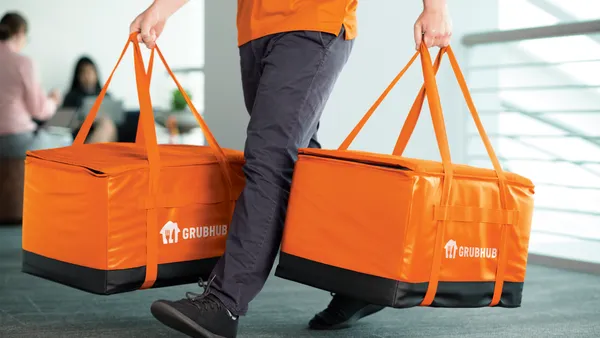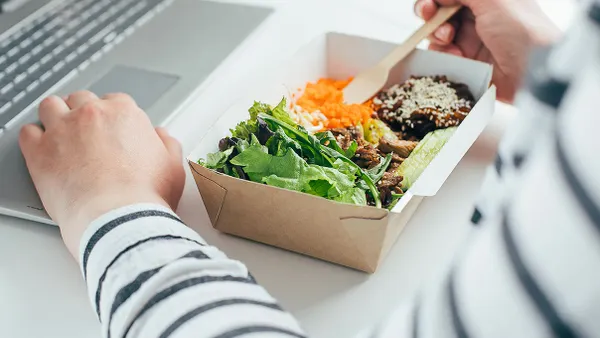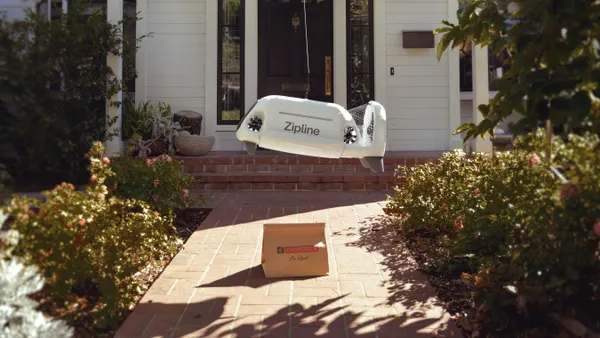Dive Brief:
- Ghost kitchens, or cooking facilities that produce food only for delivery with no dine-in or customer facing areas, could create a $1 trillion global opportunity by 2030, according to a Euromonitor virtual webinar presented by Euromonitor's Global Food and Beverage Lead Michael Schaefer. The firm predicts cheaper, faster and more reliable delivery could help this segment capture 50% of drive-thru service ($75 billion), 50% of takeaway foodservice ($250 billion), 35% of ready meals ($40 billion), 30% of packaged cooking ingredients ($100 billion), 25% of dine-in foodservice ($450 billion), and 15% of packaged snacks ($125 billion).
- Diners are becoming more comfortable with food delivery. Restaurant closures, in the wake of the novel coronavirus pandemic, will drive a change in how physical restaurant formats are being used, especially as shuttered businesses leave empty real estate behind, Schaefer said. This shift will prime the industry for an acceleration in ghost kitchen development, he said. Global foodservice delivery sales more than doubled from 2014 to 2019, and 52% of global consumers are comfortable ordering from a delivery-only restaurant with no physical storefront.
- "We expect in the current pandemic we'll see more of this repurposing, real estate operators doing anything they can to drive revenue from their existing properties. Likewise we're going to see a lot of new operators looking to fill the void with cheaper concepts ... more delivery-friendly concepts that require less capital up front," Schaefer said.
Dive Insight:
One of the main drivers of the growth of the ghost kitchen market is the changing cost structures of the foodservice environment, Schaefer said. Ghost kitchens push restaurant cost structures toward delivery rather than in-person dining, and the reduction of employees that comes with a delivery-focused model can significantly bring down rent and staffing costs for restaurants and grow thin margins, he said.
For example, 60% of the cost of a Starbucks latte represents the cost of rent and staffing, according to Euromonitor, which cited data from Financial Times. As delivery becomes less expensive and ghost kitchens grow and become more centralized, reducing food delivery times in the process, restaurants could find financial gains in optimizing their business for off-premise rather than dine-in experience.
"The real bellwether post-COVID of how much ground delivery is gaining is what happens in the drive-thru realm. If we see markets like the U.S. and others with significant drive-thru traffic moving in the direction of delivery, if we ever see drive-thru traffic moving backwards — certainly not happening right now — that is a very strong sign of a sea change, an inflection point, being reached in the overall market," Schaefer said.
The U.S. currently has 1,500 ghost kitchens, putting it ahead of the U.K. market (750) but behind China (7,500+) and India (3,500+), according to Euromonitor data. The global restaurant industry was marked by third-party delivery expansion from 2010-2015, as restaurants wanted to get in the off-premise game, but didn't have the capacity to launch their own delivery. 2020 and beyond will be defined by a proliferation of ghost restaurants driving a rise in virtual restaurants, or prepared food brands that exist only online with no physical locations, Schaefer said.
In the future, a more robust ghost kitchen market could also usher in advanced restaurant automation, Schaefer said. In five to 10 years, this shift could translate to full automation for the production of certain menu items, like pizza, ramen or high-end coffee, to drive speed of service and lower food production costs, he said.
Currently, third-party platforms such as Uber Eats, Kitchen United, Cloud Kitchens and Kitopi have been leading ghost kitchen development. But major restaurant chains are dabbling in the space as well. Bloomin' Brands is piloting kitchen-only formats for takeout and delivery orders, McDonald's opened a ghost restaurant in London last year and Chick-fil-A is experimenting with kitchen-only locations in Nashville and Louisville, Kentucky, that prepare individual and catering orders for delivery through DoorDash.
Deep-pocketed chains are leading restaurant-driven experimentation in this space, but as millions of small restaurants close permanently due to COVID-19 disruption, this strategy could give surviving small players the chance to buy up new property and continue to cater to increased delivery demand, leveling the playing field.












